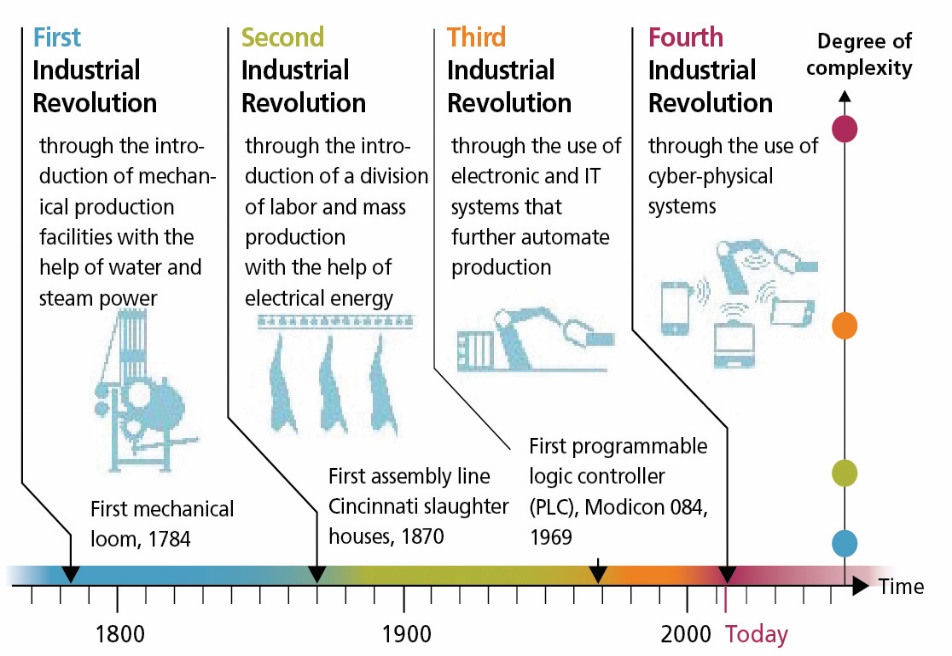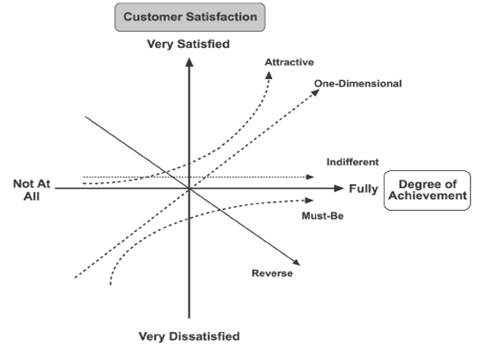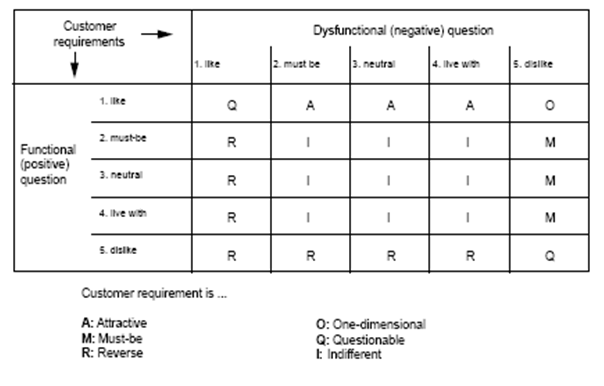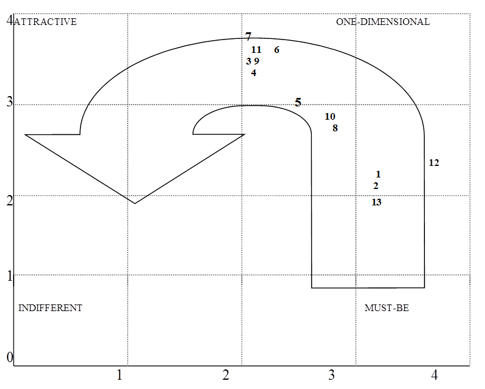Abstract
Industry 4.0 is a new concept that emerged as an industrial revolution, aiming to achieve efficient production in smart factories where a virtual copy of the physical world is built by cyber-physical systems and integrated systems are involved. This concept is a collective term that includes contemporary information, communication, automation systems and production technologies. Undoubtedly, every technical or industrial system involves people; however, the matter in question is the role of people in this system where robots and technology dominate. It is difficult to describe how Industry 4.0 is going to be implemented and what effect people are going to have in this system, particularly in sectors that require intensive labor like tourism. Based on a modern marketing approach that has placed customers at the center, it is thought that it might be useful to define the role of people and robots in tourism by listening to the voice of customer (VOC). In this study, the expectations of the customers regarding the service delivery of accommodation enterprises was compared with the use of robots and automation systems within the scope of Industry 4.0. in terms of human factor. In this regard, it was aimed to determine the attitudes and expectations of 67 customers who often purchased hotel services, by using snowball sampling method and the KANO model. According to the results of the research, it was determined that automation and robot systems affect customer satisfaction in certain service categories, while customers give priority to human factor in some other services.
Keywords: Industry 40tourism 40kano modelvoice of customer
Introduction
Today, competitive advantage is based on strategies that are developed to sustain high production levels and offer quality products on time (Endrenyi et al., 2001). The factories and electrification systems operating with steam engines in the 19th and early twentieth centuries switched to mass production. The industry was automated with the use of electronic systems and information technologies in the 1970s (Rüssman et al., 2015). Called as the fourth industrial revolution, Industry 4.0, although not a widespread concept, has a great potential to improve many aspects of human life. Industry 4.0 is the term that is used to describe the next phase of these progressions, and it comprises the activities that establish a connection between hardware and software by using Cyber Physical Systems (CPS), Internet of Objects (IoT), Large Data and Cloud Computing (Chestworth, 2018).
Whatever the structure of any technical or industrial system is, there are always people in it; systems cannot create themselves. Behind every new idea are expert designers, expert engineers and software designers who are working to transform the ideas into software. However, the role of the people in these systems is not clearly defined most of the time. It is possible to see people working in front of computer screens or running production machines. On the other hand, it is difficult to understand the people and their roles behind these systems. Besides, customers, especially of the products produced in the service industry are often part of the production process. In the case of a complex system such as the concept of Industry 4.0, the whole society is in the "output" part of the automatic production process (Kinzel, 2016). It can be said that the human factor has a special significance for the customer who is a part of the service production process, particularly in experience-based services like the tourism industry compared to others.
With regard to Industry 4.0, one cannot be thinking only about robots and the automation of production because it is a digitization of business processes as a whole; it involves the adoption of a contract over the procurement of materials and how the product “gets” through production and is finally delivered to the customer. In this area, we expect automating processes that will require a certain automaticity of the workers. People will still have to use their brains (Ivanovic, et.al. 2016). ICT innovations have to enable the connection between a customer and a service provider. The “process”, one of the primary elements of the service marketing mix, begins with customer expectations about the technology abilities that have an influence on customer satisfaction, and thus on customer retention (Roblek, 2015).
At this point, it is thought that one of the most effective ways to make a decision between the use of robot and automation systems and the human element in service delivery is to determine customer expectations. The voice of customer concept, used to determine customer expectations in the process of product or service development, is of great importance. The Voice of Customer is a broad term used to describe the process of capturing customer’s requirement for service in terms of fulfilling their needs and meeting their expectations. It produces a detailed set of customer wants and needs which are organized into a hierarchical structure, and then prioritized in terms of relative importance and satisfaction with current alternatives (Gaskin et al., 2018).
In this study, it was aimed to compare the expectations of customers of accommodation enterprises with regards to receiving the service either from robots and automation systems within the scope of Industry 4.0, or humans. For this purpose, the Kano Model was used to categorize customer expectations. According to the results of the research, it was tried to identify the place of the use of systems within Industry 4.0 instead of the human element in customer expectations for services of accommodation enterprises.
Literature Review and Theoretical Framework
Industry 4.0 – Tourism 4.0 and Human Factor
The original Industrial Revolution, which started in the early 1760s, is called Industry 1.0, which was based on division of labor and steam / hydro power. This revolution was followed by Industry 2.0, led by the development of electricity. Today, Industry 3.0, which is based on Information and Communication Technologies (ICT) enabling the advancement of production and service sectors in particular, has come to a point of completion. Now, sensors, RFID chips, "cyber-physical" systems and the Internet of Objects (IoT) manage production and service processes throughout the entire supply chain. An important component of these changes is the decentralized control: smart components work in every stage where system, a part, an order or information moves. In this system, effective communication is used at every step. Whenever needed, any addition, processing, and application is easily accomplished, and increased number of customer demands are met more easily and quickly. Industry 4.0, introduced globally by German companies such as Siemens, has gradually begun to be used across the globe (Srivastava, 2015). The four stages of the industrial development process are shown in Figure

Industry 4.0 of which global recognition is gradually increasing affects three main areas in the corporate world: integration and digitization of horizontal and vertical value chains; digitalization of products and services; the formation of the digital business model and customer relations (Guban & Kovacs, 2017). “Industry 4.0” has the main features of virtualization, interoperability, autonomization, real-time availability, flexibility, service orientation and energy efficiency. On the other hand, which technologies and concepts may be classified under the term “Industry 4.0” in these three areas is being investigated and identified. In this respect, many technologies and concepts have been analyzed and grouped into 4 relevant and representative headings: Cyber-Physical Systems (CPS), Internet of Things/Services (IoT/IoS), Smart Data, and Smart Factory. Finally, in what ways the aforementioned technologies and concepts provide the features of Industry 4.0 and serve its purpose has been identified (Prales, Alarcon & Bacon, 2016 ).
In a study done on the automotive industry, one of the leading sectors where Industry 4.0 is becoming increasingly widespread, the production industry in Germany was examined and it was found that these systems make significant contributions in terms of efficiency (Rubman, 2015). The physical product sector, where the human element is extensively being used in ordinary jobs during the production process, it has been found that with robots replacing people, there is a decrease in costs, a decrease in production mistakes and an increase in productivity. An analysis of the impact of Industry 4.0 on German production is expected to result in an increase of 6% in employment over the next decade. The demand for workers in the mechanical-engineering sector has been suggested to increase by up to 10% during the same period. However, it seems that different skills will be needed. In the short run, it is predicted that the trend towards greater automation will overtake some of the low-skilled workers who perform simple, repetitive tasks. At the same time, it is stated that the increasing use of software, links and analytics will raise the demand for mechatronics specialists with various engineering disciplines and software skills like software development as well as IT technology competencies. This transformation of competence in employment is considered to be one of the important challenges for qualified employment in the future (Rubman, 2015).
While the human resource factor in the physical product sector stands out, there is a debate as to whether the future replacement of human factor by robots is advantageous in the tourism sector, one of the labor-intensive sectors. It is clear that systems do not create themselves. There are teams of experts behind every new idea and very specialized engineers and software designers are required to convert these ideas into working software (Kinzel, 2016).
The role of the human in Industry 4.0 has been treated in four different ways. The first one is
In short, it seems that human beings should be a part of this system as a service provider or consumer. As mentioned above, one of the areas that Industry 4.0 influences is customer relations. In tourism services where delivering service is labor-intensive, there are customers who aim to experience and take pleasure from this experience. It can be seen that determining the expectations of the customers to receive services from robots and automation systems instead of people, or to participate in the process as a part of the system in this sector seems to be a subject that is worth to be investigated.
Voice of Customer and Kano Model
Voice of customer is the first phase of Quality Function Deployment (QFD) which aims to improve the quality of products and services to increase consumer satisfaction (Mazur, 1996). The Voice of the Customer process has important outputs and benefits for product developers. It provides a detailed understanding of the customer’s requirements, a common language for the team going forward in the product development process, key input for the setting of appropriate design specifications for the new product or service, and a highly useful springboard for product innovation. As may be seen in the examples presented, gathering the Voice of Customer is an extremely important part of the new product development process. It forms a solid basis for design and marketing decisions from concept development through product launch (Gaskin, et al., 2018).
One of the most well-known methods used to determine customer requirements is the Kano Model. Understanding customer’s requirements and determining their differences are important for their management. Focusing on customer should be done not only to respond to the customer’s demands, but also to understand what those requirements are for. There are classical methods like interviews and focus groups, but there is also the “Kano Model” used in classifying the requirements (Okul, 2007). The Kano Model is a model which is used in order to categorize the customer’s requirements. In classical methods, there is a simple logictating that responding to customer’s requirements will lead to customer satisfaction, and not responding to these requirements will lead to dissatisfaction. However, the Kano Model classifies the customer requirements and determines the level of satisfaction (Bilgili & Ünal, 2008).
The requirements described in the Kano Model are shown in Figure

According to this model, the features that the customer mainly expects from the product are defined in three ways (Kano et. al., 1984; Delice & Güngör, 2008; Bilgili, Erciş & Ünal, 2011):
Research Method
Sample and Data Collection
In this study, which of both of a qualitative and a quantitative quality, it has been tried to determine future consumer expectations for the possible applications of Industry 4.0 in accommodation enterprise services. The population of the study consists of consumers who are experienced in accommodation services. By using the snowball sampling method, 67 people who intensively purchased hotel services were included in the research sample. 13 main service items were determined in the accommodation enterprises, and the questionnaires were prepared using these services. Participants included in the research sample were explained and helped to visualize the applications that can be realized within the scope of Industry 4.0 in accommodation enterprises. Participants' expectations within this framework were tried to be determined through questionnaires prepared by the KANO model. The frequencies of the data in the questionnaires were obtained from the SPSS statistical program and manually calculated.
Analyses
The questionnaire from which the primary data was collected consists of questions regarding the accommodation enterprise services, which were categorized under 13 main headings. In the original version of the theory of attractive quality (Kano et al., 1984) the classification process is based on a survey using a Kano questionnaire. This questionnaire is constructed through pairs of customer requirement questions. Each question consequently has two parts: how do you feel if that feature is present in the Industry 4.0 (functional form of the question), and how do you feel if that feature is not present in the Industry 4.0 (dysfunctional form of the question) (see Kano et al., 1984; Berger et al., 1993). For each part of the questions, the customer selects one of five alternative answers. These five alternatives were described as “like”; “must-be”; “no feeling”; “give up”; and “do not like” (Kano et al., 1984). The perceptions were then evaluated into quality dimensions on the basis of how the respondents perceived the functional and dysfunctional form of a quality attribute.The five-level Kano classification are Attractive quality (A), One-dimensional quality; (O), Must-be quality (M), Indifferent quality (I), Reverse quality (R).
In order to be able to distribute the needs according to the categories, the importance level of providing services with Industry 4.0 applications was asked with 5-point Likert-type scale. Thus, in accordance with the Kano Model, participants were addressed 3 different questions related to a service delivery (Figure.

Findings
53, 7% of the participants were women, 44, 8% were between 28-37 age group, 49, 3% were university students, 38, 8% had post-graduate education level, 53, 7% were married, and 71,6% earned 4000 TL and above.
52, 3% of the participants purchased hotel services at least 5 times a year, 53, 7% purchased 5-star hotels, 53, 7% purchased city hotels and 46, 3% purchased resort hotel services.
A frequency analysis was conducted to determine which group the participants’ expectations fall in regarding Industry 4.0 applications (robot / automation instead of human in service delivery) in accommodation services. The most frequent three requirements for each requirement are shown in Table
According to the results of the frequency analysis performed to determine the frequency of repetition; of the 13 requirements, 11 were identified as the ones that did not make a difference and 2 were opposite requirements. Security services, technical support services, sales / marketing and customer services, and housekeeping are among the most frequently mentioned requirements that do not make a difference. The opposite requirements include reception-front desk services and kitchen services. Based on the frequencies, it can be said that the participants perceive robot / automation as a service that does not make a difference in technical services where the role of a person is not much in such accommodation services. It can be said that the use of robot / automation in technical services and automatic face recognition systems is perceived as exciting, or in other words, satisfactory.
After the initial classification according to the most frequent replies, the customer satisfaction coefficients are calculated to determine the variables that are closer to the one dimensional needs and closer to the attractive requirements. The formulas for calculating customer satisfaction coefficients are shown in Table
Customer satisfaction coefficients of the variables were calculated; because there was no variable with a negative coefficient, there wasn’t a one-dimensional classification. In other words, it was seen that accommodation service consumers do not perceive robot / automation as an application that should be used in service delivery.
Those who exceeded 0.10 of the variables with positive customer satisfaction coefficients were accepted as closer to the attractive requirements. These variables are presented in Table
As can be seen in Table
Variables with a satisfaction coefficient of less than 0.10 and above 0 were close to both attractive requirements and one dimensional requirements. According to the results, reservation services, customer services and personal care services are the requirements that take place in this group.
There was no one-dimensional or close variable with a significance level of above 4. Therefore, no conversion was performed. For the ease of understanding, variables with a significance level of between 3 and 4 were not converted either.
According to the results obtained from the research, it is seen that only automatic face recognition and keyless entry-exit services at the importance level of 3.50 among consumers' requirements are seen. The locations of the service requirements relative to the "x" and "y" values are shown in Figure

As can be seen from the requirements, automatic entry-exit systems have been included in the must-be requirements; all other services are in one dimensional requirements.
Conclusion and Discussions
In the survey, the requirements of consumers for robotic / automation use within the scope of the concept of Industry 4.0 in the accommodation services have been categorized according to the canoe model. At the first stage of the analysis, the participants' expectations for robot / automation systems are reverse or indifferent in their accommodation services. In the second stage, customer satisfaction coefficients were calculated. According to the results, the use of robot / automation in some services has been found to be in the group of attractive requirements and one dimensional requirements. Also, the use of robot/automation systems in entry-exit is in the category of must-be. According to the results, consumers are waiting for the use of the human in some of these services. In some services, the use of robot / automation systems is considered as one dimensional or attractive requirement. Therefore, it is possible to say that the voice of the customer should be heard in the tourism industry, especially in the applications of the industry 4.0 in accommodation services. It will be useful to determine the transition and implementation strategies to this system according to customer expectations analysis. It is recommended that those who will do research on this area should conduct detailed research for each service on larger masses.
References
- Berger, C., Blauth, R., Boger, D., Bolster, C., Burchill, G., DuMouchel, W., Pouliot, F.,...Walden, D. (1993). Kano’s methods for understanding customer-defined quality. The Center for Quality Management Journal, 2 (4), 2-36.
- Bilgili, B., Yağmur, Ö., & Yazarkan, H. (2012). A Research on the efficiency and productivity of festivals as a touristic product (sample of Erzurum-Oltu Kırdağ festival). Nobel International Journals, 2 (2), 117-124.
- Bilgili, B., Erciş, A., & Ünal, S. (2011). Kano model application in new product development and customer satisfaction (adaptation of traditional art of tile making to jewelries). Procedia Social and Behavioral Sciences, 24, 829-846.
- Bilgili, B., & Ünal, S. (2008). Kano model application for classifying the requirements of university students. Management of International Business and Economics Systems 2008 Conference, Department of Business Administration, School of Business and Economics, Technological Institute of Larissa, Greece, 155-170.
- Chestworth, D. (2018). Industry 4.0 techniques as a maintenance strategy (a review paper). Retrieved from https://www.researchgate.net/publication/322369285_Industry_40_Techniques_as_a_Maintenance_Strategy_A_Review_Paper.
- Endrenyi, J., Aboresheid, R., Allan, R.N., Anders, G.J., Asharpoor, S., Billintion, R.,…Sing, CH. (2001). The present status of maintenance strategies and the impact of maintenance on reliability. IEE Transactions on Power Systems, 16 (4), 638–646.
- Delice, Kılıç. E., & Güngör, Z. (2008). Müşteri isteklerinin siniflandirilmasinda kano model uygulaması. X. Akademik Bilişim Konferansı, 30 Ocak-1 Şubat, Çanakkale.
- Dhanani, S. (2014). Realizing industry 4.0: essential system considerations. Retrieved from http://www.eenewseurope.com/news/realizing-industry-40-essential-system-considerations
- Gaskin, S.P., Grrifin, A., Hauser, J.R., Katz, G.M., & Klein, R.L., (2018). Voice of the customer. Retrieved from http://www.mit.edu/~hauser/Papers/Gaskin_Griffin_Hauser_et_al%20VOC%20Encyclopedia%202011.pdf.
- Guban, M., & Kovacs, G. (2017). Industry 4.0 conception. Acta Technica Corviniensis-Bulletin of Engineering, 1, (January-March).
- Helander, M. (2006). A Guide to human factors and ergonomics. New York: Taylor & Francis Group.
- Ivanovic, S., Milojica, V., & Roblek, V. (2016). A holistic approach to innovations in tourism. International Confeence on Economic and Social Studies, 29 September, Sarajevo, Bosnia and Hercegovina.
- Kano, N., Seraku, N., Takahashi, F, & Tsjui, S. (1984). Attractive quality and must-be quality. Journal of the Japanese Society for Quality Control 14 (2),147-156.
- Kinzel, H. (2016). Industry 4.0 – where does this leave the human factor?, 27th Annual Conference of Human Dignity and Humiliation Studies 'Cities at Risk - From Humiliation to Dignity, 19-23 September, Dubrovnik, Croatia. Retrieved from https://www.researchgate.net/publication/308614137_Industry_40_-_Where_does_this_leave_the_Human_Factor.
- Kramer, B., & Zimolong, B. (2005). Führungsverantwortung für die Arbeitssicherheit in sozioökonomischen Systemen. Beiträge zur Mensch-Maschine-Systemtechnik aus Forschung und Praxis: Festschrift für Klaus-Peter Timpe, 367-386. Düsseldorf.
- Mazur, G. (1996). Voice of customer analysis: a modern system of front-end QFD tools, with case studies. Retrieved from http://www.mazur.net/works/voice_of_customer.pdf
- Okul, D. (2007). Analitik ağ süreci ve bulanık mantık kullanımıyla kalite fonksiyon yayılımının mobilya sektöründe uygulaması (Yüksek Lisans Tezi), Gazi Üniversitesi, Ankara.
- Prales, D.P, Alarcon, F. & Boza, A. (2016). Industry 4.0: A classification scheme. International Joint Conference-CIO-ICTEOM-IIE-AIM, July 13-15, Spain.
- Roblek, V. (2015). Impact of internet and social media on organisational change of otc medicines marketing management. International Journal of Electronic Marketing and Retailing, 6 (3), 239- 258.
- Rüssmann, M., Lorenz, M., Gerbert, P., Waldner, M., Justus, J., Engel, P., & Harnisch, M. (2015). Industry 4.0: The future of productivity and growth in manufacturing industries. Retrieved From http://www.inovasyon.org/pdf/bcg.perspectives_Industry.4.0_2015.pdf.
- Srivastava, S.K. (2015). Industry 4.0. BHU Engineer’s Alumni, November 15, 23-24.
- Witell, L., & Löfgren, M. (2007). Classification of quality attributes, Managing Service Quality, 17 (1), 54-73.
Copyright information

This work is licensed under a Creative Commons Attribution-NonCommercial-NoDerivatives 4.0 International License.
About this article
Publication Date
28 January 2019
Article Doi
eBook ISBN
978-1-80296-053-2
Publisher
Future Academy
Volume
54
Print ISBN (optional)
-
Edition Number
1st Edition
Pages
1-884
Subjects
Business, Innovation, Strategic management, Leadership, Technology, Sustainability
Cite this article as:
Bilgili, B., & Özkul, E. (2019). Industry 4.0-Tourism 4.0 And Human Factor: Voice Of Customer. In M. Özşahin, & T. Hıdırlar (Eds.), New Challenges in Leadership and Technology Management, vol 54. European Proceedings of Social and Behavioural Sciences (pp. 655-667). Future Academy. https://doi.org/10.15405/epsbs.2019.01.02.55
